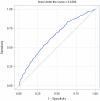Predictors of occurrence and severity of first time low back pain episodes: findings from a military inception cohort
- PMID: 22355317
- PMCID: PMC3280257
- DOI: 10.1371/journal.pone.0030597
Predictors of occurrence and severity of first time low back pain episodes: findings from a military inception cohort
Abstract
Primary prevention studies suggest that additional research on identifying risk factors predictive of low back pain (LBP) is necessary before additional interventions can be developed. In the current study we assembled a large military cohort that was initially free of LBP and followed over 2 years. The purposes of this study were to identify baseline variables from demographic, socioeconomic, general health, and psychological domains that were predictive of a) occurrence; b) time; and c) severity for first episode of self-reported LBP. Baseline and outcome measures were collected via web-based surveillance system or phone to capture monthly information over 2 years. The assembled cohort consisted of 1230 Soldiers who provided self-report data with 518 (42.1%) reporting at least one episode of LBP over 2 years. Multivariate logistic regression analysis indicated that gender, active duty status, mental and physical health scores were significant predictors of LBP. Cox regression revealed that the time to first episode of LBP was significantly shorter for Soldiers that were female, active duty, reported previous injury, and had increased BMI. Multivariate linear regression analysis investigated severity of the first episode by identifying baseline predictors of pain intensity, disability, and psychological distress. Education level and physical fitness were consistent predictors of pain intensity, while gender, smoking status, and previous injury status were predictors of disability. Gender, smoking status, physical health scores, and beliefs of back pain were consistent predictors of psychological distress. These results provide additional data to confirm the multi-factorial nature of LBP and suggest future preventative interventions focus on multi-modal approaches that target modifiable risk factors specific to the population of interest.
Conflict of interest statement
Figures


References
-
- Mantyselka P, Kumpusalo E, Ahonen R, Kumpusalo A, Kauhanen J, et al. Pain as a reason to visit the doctor: a study in Finnish primary health care. Pain. 2001;89:175–180. - PubMed
-
- Walker BF, Muller R, Grant WD. Low back pain in Australian adults: prevalence and associated disability. J Manipulative Physiol Ther. 2004;27:238–244. - PubMed
-
- Stewart WF, Ricci JA, Chee E, Morganstein D, Lipton R. Lost productive time and cost due to common pain conditions in the US workforce. JAMA. 2003;290:2443–2454. - PubMed
-
- Cohen SP, Brown C, Kurihara C, Plunkett A, Nguyen C, et al. Diagnoses and factors associated with medical evacuation and return to duty for service members participating in Operation Iraqi Freedom or Operation Enduring Freedom: a prospective cohort study. Lancet. 2010;375:301–309. - PubMed
Publication types
MeSH terms
Grants and funding
LinkOut - more resources
Full Text Sources
Medical
Miscellaneous

